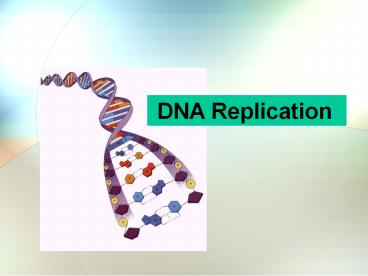DNA Replicat - PowerPoint PPT Presentation
Title:
DNA Replicat
Description:
Title: DNA Replicat Author: Joe & Sandra Albo Last modified by: Williams, Angie Created Date: 2/1/2006 1:35:14 AM Document presentation format: On-screen Show (4:3) – PowerPoint PPT presentation
Number of Views:136
Avg rating:3.0/5.0
Title: DNA Replicat
1
DNA Replication
2
What does DNA stand for?
- D deoxyribo N nucleic A acid
- Put it all together and it spells-
- deoxyribonucleicacid
3
What is DNA Replication?
- Process by which-
- a cell makes a copy of the DNA in its nucleus.
4
When does DNA Replication occur? Before
Mitosis begins- Interphase
Cell Division Stage1- Interphase
5
- Why is DNA Replication an important cell process?
- Ensures that each daughter cell will have all of
the genetic information it needs to carry out its
activities.
Forming daughter cell
DNA (genetic information)
Forming daughter cell
DNA (genetic information)
6
History of DNAs Discovery
- 1950s scientists showed DNA carries all
cells instructions. - Learned DNA passed from parent cell to its
daughter cells. - 1953 James Watson and Francis Crick discovered
structure of DNA. - - Revealed important information about how
DNA copies (replicates) itself.
7
Appearance of DNA
- Looks like spiral staircase or twisted ladder
- Often called double helix
- helix-
- shape that twists like threads of a screw
8
Structure of DNA
Phosphate
- Sides (DNA Ladder)
- Alternating molecules of
- Deoxyribose sugar
- Phosphate
- Rungs (DNA Ladder)
- Made up of pairs of nitrogen bases
- adenine
- thymine
- cytosine
- guanine
Deoxyribose sugar
Nitrogen base
9
Ladder Rungs
- Letters A, T, G, C
- Used to represent the four bases that make up
ladders rungs - Nitrogen bases on one side of ladder match up
in specific way with bases on the other side. - Adenine always pairs with Thymine (A-T)
- Guanine always pairs with Cytosine (G-C)
Nitrogen Base
Nitrogen base
10
- Pairing pattern of the nitrogen bases
- key to understanding how DNA replication occurs.
11
Replication Process
- Step 1
- Two sides of the DNA molecule unwind and separate
between paired nitrogen bases on each rung. - Like a zipper unzipping
12
Replication Process
- Step 2
- Nitrogen bases floating in nucleus pair up with
bases on each half of the DNA molecule. - A always pairs with T
- G always pairs with C
13
Replication Process
- Step 3
- Once new bases are attached, two new DNA
molecules formed. - Order of bases in each new DNA molecule exactly
matches the order in the original molecule.
14
- http//www.cfkeep.org/uploads/dna_replication.mov
http//video.search.yahoo.com/search/video?pdnas
tructureeiUTF-8frsbc-webxwrt
15
Chromatin
- DNA wraps around proteins and takes the form of
chromatin, it looks like loose coils or
spaghetti, very long. In the nucleus.
16
Chromosome
X- shaped structures composed of tightly coiled
DNA One comes from the mother and one comes from
the father. This happens during cell division.
They will attach in the middle, which forms a
Gene.
17
Gene
18
(No Transcript)
19
Applying What You Have Learned
- Lab
- Marshmallow DNA Replication
- Write down a code of 5 base pairs
- Ex A-T, T-A, G-C, G-C, T-A
- Using colored marshmallow make your base pairs
and place them in the order of your code - Green Adenine Yellow Thymine
- Pink Guanine White Cytosine
- Use a broken demonstrated shown
- Make sides of ladder, as demonstrated
- Deoxyribose
- Phosphate
20
- Base-Pairing Mini-Lab
- Materials
- Small Marshmallows of 4 different colors
- Large White marshmallows
- Small White marshmallows
- Toothpicks
- Directions
- Use your knowledge of how the base pairs of DNA
bond to create an accurate model of a DNA code
that is handed to you at the start of the lab - Use the colored marshmallows to represent the
different base pairs, the large white
marshmallows to represent the sugar, and the
small white marshmallows for the phosphate
groups. Keep in mind that purines bases are
larger than pyrimidine bases! - Record your random 7-digit code here
___________________________________ - Use the space below to create a key that will
identify the parts of the model, and their
corresponding parts in DNA - Follow-up Questions
- 1. What is the sugar that makes up DNA?
- 2. How does the number of adenines compare to
the number of thymines? How about cytosines to
guanines? Provide sample numbers. - 3. How do the number of purines compare to the
number of pyrimidines? Provide sample numbers.
21
- DNA Extraction Lab































